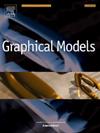Discrete variable 3D models in Computer extended Descriptive Geometry (CeDG): Building of polygonal sheet-metal elbows and comparison against CAD
IF 2.2
4区 计算机科学
Q2 COMPUTER SCIENCE, SOFTWARE ENGINEERING
引用次数: 0
Abstract
The Computer extended Descriptive Geometry (CeDG) is as a novel approach based on Descriptive Geometry to build 3D models within the framework provided by Dynamic Geometry Software tools. Parametric CeDG models can be interactively explored when continuous parameters change, but this is not the case for discrete parameters. This study demonstrates the capability of the GeoGebra - CeDG approach to incorporate algorithms that build discrete variable 3D models with dynamic parameterization. Several 3D models and their flattened patterns (neutral fiber), based on a new developed CeDG algorithm, were compared to their LogiTRACE v.14 and Solid Edge 2024 (CAD) counterparts. The accuracy of the CeDG models surpassed that of CAD models for nearly all dimensions defined as metrics. In addition, the CeDG approach was the unique that provided an automatic solution for any value of the number of ferrules.

计算机扩展描述几何(CeDG)中的离散变量三维模型:多边形金属板弯头的建立及其与CAD的比较
计算机扩展描述几何(CeDG)是一种基于描述几何的新方法,可以在动态几何软件工具提供的框架内构建3D模型。当连续参数发生变化时,可以交互式地探索参数CeDG模型,但对于离散参数则不是这样。这项研究展示了GeoGebra - CeDG方法的能力,该方法结合了建立具有动态参数化的离散变量3D模型的算法。基于新开发的CeDG算法,将几种3D模型及其扁平图案(中性纤维)与LogiTRACE v.14和Solid Edge 2024 (CAD)模型进行了比较。在几乎所有被定义为度量的维度上,CeDG模型的精度都超过了CAD模型。此外,CeDG方法是一种独特的方法,可以为任何套头数量的值提供自动解决方案。
本文章由计算机程序翻译,如有差异,请以英文原文为准。
求助全文
约1分钟内获得全文
求助全文
来源期刊

Graphical Models
工程技术-计算机:软件工程
CiteScore
3.60
自引率
5.90%
发文量
15
审稿时长
47 days
期刊介绍:
Graphical Models is recognized internationally as a highly rated, top tier journal and is focused on the creation, geometric processing, animation, and visualization of graphical models and on their applications in engineering, science, culture, and entertainment. GMOD provides its readers with thoroughly reviewed and carefully selected papers that disseminate exciting innovations, that teach rigorous theoretical foundations, that propose robust and efficient solutions, or that describe ambitious systems or applications in a variety of topics.
We invite papers in five categories: research (contributions of novel theoretical or practical approaches or solutions), survey (opinionated views of the state-of-the-art and challenges in a specific topic), system (the architecture and implementation details of an innovative architecture for a complete system that supports model/animation design, acquisition, analysis, visualization?), application (description of a novel application of know techniques and evaluation of its impact), or lecture (an elegant and inspiring perspective on previously published results that clarifies them and teaches them in a new way).
GMOD offers its authors an accelerated review, feedback from experts in the field, immediate online publication of accepted papers, no restriction on color and length (when justified by the content) in the online version, and a broad promotion of published papers. A prestigious group of editors selected from among the premier international researchers in their fields oversees the review process.
 求助内容:
求助内容: 应助结果提醒方式:
应助结果提醒方式:


